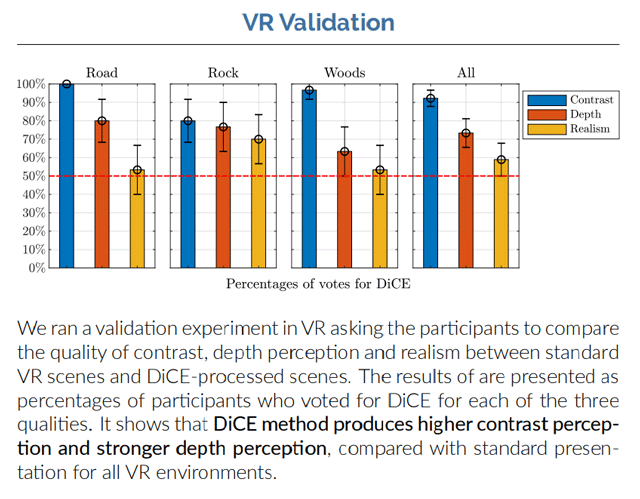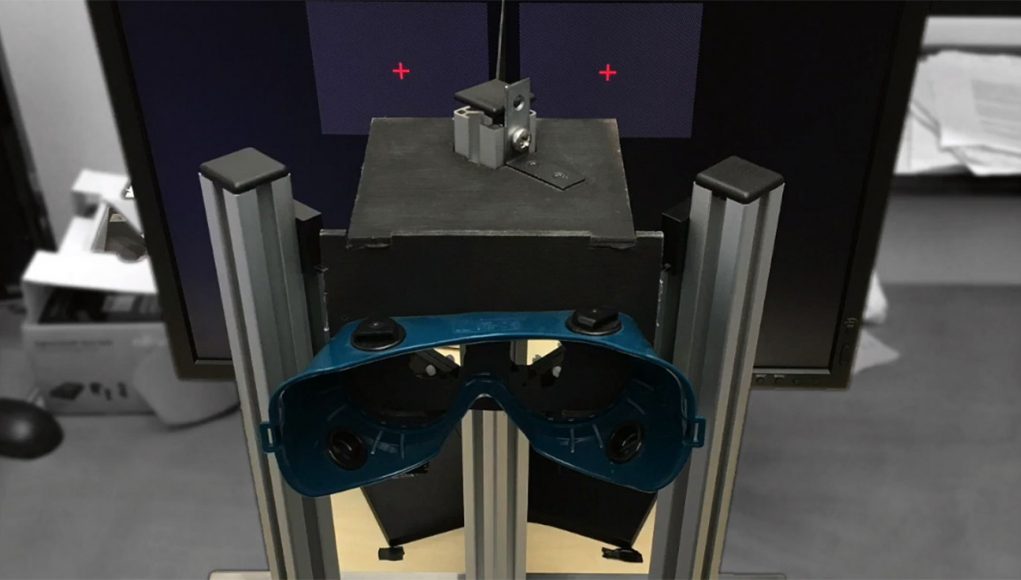A team of researchers from Cambridge, Berkeley, MIT, and others has developed a novel method for boosting perceived contrast in VR headsets. The method exploits human stereo vision by intentionally mismatching elements of the view seen by each eye; the brain resolves the conflict in a way that boosts perceived contrast, the researchers say.
In the latest round of VR headsets, most major headset makers have moved from OLED displays to LCD displays. The latter offers greater pixel density, a reduced screen door effect, and likely lower cost, with the biggest trade-off being in contrast ratio. While OLED displays offer a wide contrast range and especially deep blacks, LCD displays in today’s headsets deliver a more ‘washed-out’ look, especially in darker scenes.
Researchers from Cambridge, Durham, Inria, Université Côte d’azur, Berkeley, Rennes, and MIT have developed a novel method which could help boost perceived contrast in VR headsets. The system is called DiCE, which stands for ‘Dichoptic Contrast Enhancement’. In a paper published earlier this year in the ACM Transactions on Graphics journal, the researchers say the method has “negligible computational cost and can be directly used in real-time VR rendering.”
The researchers say that while tone mapping methods can boost perceived contrast in images, they are too slow and computationally expensive for practical use in VR rendering. Instead they propose a system which exploits the natural behavior of the human stereo vision system fool it into perceiving greater contrast.
Generally speaking, the goal in VR headsets is to always render stereo-accurate views; if the image shown to each eye has unexpected differences, it creates ‘binocular rivalry’ (AKA stereo-conflict) which can be visually uncomfortable as it creates a mismatch which is difficult for the brain to properly fuse into a coherent image. The DiCE method aims to exploit mismatched stereo images for enhanced contrast while preventing binocular rivalry. A video summary explains:
A key component to the method is figuring out how to render the images to enhance contrast without causing significant binocular rivalry. The researchers say they devised an experiment to determine the factors which lead to binocular rivalry, and then designed the stereo-based contrast enhancement to avoid those factors.
The main challenge of our approach is striking the right balance between contrast enhancement and visual discomfort caused by binocular rivalry. To address this challenge, we conducted a psychophysical experiment to test how content, observer, and tone curve parameters can influence binocular rivalry stemming from the dichoptic presentation. We found that the ratio of tone curve slopes can predict binocular rivalry letting us easily control the shape of the dichoptic tone curves.
After finding an approach which minimizes binocular rivalry, the researchers tested their findings, claiming “our results clearly show that our solution is more successful at enhancing contrast and at the same time much more efficient [than prior methods]. We also performed an evaluation in a VR setup where users indicate that our approach clearly improves contrast and depth compared to the baseline.”
 The researchers believe the work is well suited for VR rendering, noting, “as tone mapping is usually a part of the rendering pipeline, our technique can be easily combined with existing VR/AR rendering at almost no [computational] cost.” The team even went so far as to publish a Unity Asset package for other researchers to play with.
The researchers believe the work is well suited for VR rendering, noting, “as tone mapping is usually a part of the rendering pipeline, our technique can be easily combined with existing VR/AR rendering at almost no [computational] cost.” The team even went so far as to publish a Unity Asset package for other researchers to play with.
The research team included Fangcheng Zhong, George Alex Koulieris, George Drettakis, Martin S. Banks, Mathieu Chambe, Fredo Durand, and Rafał K. Mantiuk.







